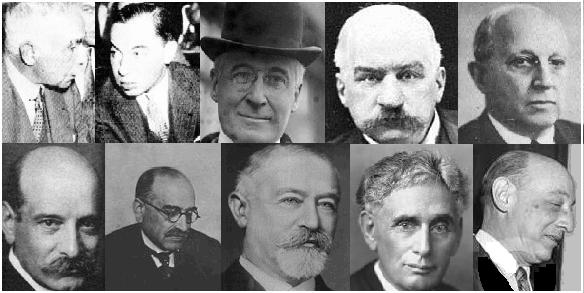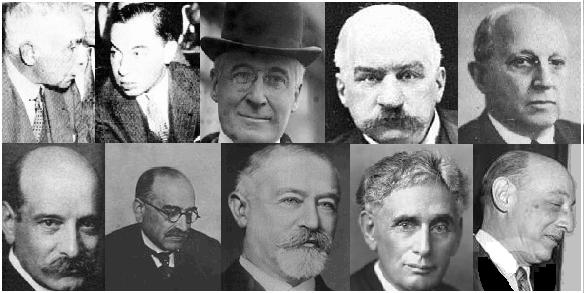
Paul Warburg was probably the most important person at the 1913 Federal Reserve establishment meeting on Jekyll Island because of his knowledge of banking as it was practiced in Europe. He was a partner in Kuhn, Loeb & Company and was a representative of the Rothschild banking dynasty in England and France where he maintained a very close working relationships throughout his entire career with his brother, Max Warburg, who was the head of the Warburg banking consortium in Germany and the Netherlands. He was also one of the wealthiest men in the world at the time.
He also called for and attended the founding of the Council on Foreign Relations in 1921. The CFR being another tool of the global elite used to oversee US foreign policy.
Wikipedia currently suffices fine for the low down on Warburg.
https://en.wikipedia.org/wiki/Paul_Warburg
Death[edit]
Warburg died at his home in New York City on January 24, 1932, and was buried in Sleepy Hollow Cemetery in Sleepy Hollow, New York. At the time of his death he was chairman of the Manhattan Company and a director of the Bank of Manhattan Trust Company, Farmers Loan and Trust Company of New York, First National Bank of Boston, Baltimore & Ohio Railroad, Union Pacific Railroad, Los Angeles & Salt Lake Railroad, Western Union Telegraph Company, American I.G. Chemical Company, Agfa Ansco Corporation, and Warburg & Company of Amsterdam.
Note this entry: https://en.wikipedia.org/wiki/American_IG
Yes, you guessed it. Its the very same I.G., as in I.G. Farben, that fueled Hitler’s war machine.
Excerpt:
American IG owes its genesis to a German business conglomerate, namely, Interessens-Gemeinschaft Farbenindustrie AG, or IG Farben for short. The business, along with the industrial empire that “IG” controlled and commanded, has been described as “a state within a state.”
The Farben cartel was created in 1925, when Hermann Schmitz, the master organizer, with Wall Street financial assistance, created the giant chemical corporation, combining six already giant German chemical companies — Badische Anilin- und Sodafabrik Ludwigshafen (BASF), Bayer, Agfa, Hoechst, Weiler-ter-Meer, and Griesheim-Elektron. These six companies were merged into Interessen-Gemeinschaft Farbenindustrie AG or, IG Farben, for short.
In year 1928, the American holdings of IG Farben, namely, the American branches of Bayer Company, General Aniline Works, Agfa Ansco, and Winthrop Chemical Company, were organized into a Swiss holding company, which was named Internationale Gesellschaft für Chemische Unternehmungen AG or IG Chemie, in short. The controlling interest of this entity rested with IG Farben in Germany. In the following year, 1929, just a decade before the outbreak of the Second World War, these American firms merged to become American IG Chemical Corporation, or American IG, later renamed General Aniline & Film.
On the eve of World War II, IG Farben, the German chemical conglomerate, was the largest manufacturing enterprise in the world and exercised extraordinary economic and political clout in Nazi Germany. In 1936, it was the principal source for Zyklon B, the poison used in German concentration camps. From 1942-1945, the company used slave labor from Nazi concentration camps. After 1945, three members of the board of governors of American IG were tried and convicted as German war criminals. In 1952, IG Farben was split into BASF, Bayer, and Hoechst again.
So there you have it. This man led the creation of the US Federal Reserve and the Council on Foreign Relations and also was the chairman and director of American I.G., the US branch of I.G. Farben, the same I.G. Farben that supplied the gas for gas chambers and fueled the German war machine in WW2. It seems clear from this action that it wasn’t simply just Hitler who was exterminating prisoners in concentration camps. Others seem to have also had a hand in the matter, including a number of directors at large companies based in the US, Germany and Switzerland.
Quite a wicked web was woven by Paul Warburg it seems. His name seems quite fitting. Paradoxically and metaphorically speaking, he seems to have been quite the Judas.
Understanding how the CFR was established. Wikipedia will suffice for a basic understanding of its early history:
https://en.wikipedia.org/wiki/Council_on_Foreign_Relations
As a result of discussions at the Paris Peace Conference, a small group of British and American diplomats and scholars met on May 30, 1919 at the Hotel Majestic in Paris and decided to create an Anglo-American organization called “The Institute of International Affairs”, which would have offices in London and New York.[2]:12[3]:5 Due to the isolationist views prevalent in American society at the time, the scholars had difficulty gaining traction with their plan, and turned their focus instead to a set of discreet meetings that had been taking place since June 1918 in New York City, under the name Council on Foreign Relations. The meetings were headed by the corporate lawyer Elihu Root, who had served as Secretary of State under President Theodore Roosevelt, and attended by 108 “high-ranking officers of banking, manufacturing, trading and finance companies, together with many lawyers.” The members were proponents of Wilson’s internationalism, but were particularly concerned about “the effect that the war and the treaty of peace might have on postwar business.”
[3]:6–7 The scholars from the inquiry saw an opportunity here to create an organization that brought diplomats, high-level government officials and academics together with lawyers, bankers, and industrialists to engineer government policy. On July 29, 1921 they filed a certification of incorporation, officially forming the Council on Foreign Relations.[3]:8–9 In 1922 Edwin F. Gay, former dean of the Harvard Business School and director of the Shipping Board during the war, spearheaded the Council’s efforts to begin publication of a magazine that would be the “authoritative” source on foreign policy. He gathered $125,000 from the wealthy members on the council, and via sending letters soliciting funds to “the thousand richest Americans”. Using these funds, the first issue of Foreign Affairs was published in September 1922, and within a few years had a gained a reputation as the “most authoritative American review dealing with international relations”.[2]:17–18
In the late 1930s, the Ford Foundation and Rockefeller Foundation began contributing large amounts of money to the Council.[4] In 1938 they created various Committees on Foreign Relations, which later became governed by the American Committees on Foreign Relations in Washington, D.C., throughout the country, funded by a grant from the Carnegie Corporation. Influential men were to be chosen in a number of cities, and would then be brought together for discussions in their own communities as well as participating in an annual conference in New York. These local committees served to influence local leaders and shape public opinion to build support for the Council’s policies, while also acting as “useful listening posts” through which the Council and U.S. government could “sense the mood of the country”.[2]:30–31
Beginning in 1939 and lasting for five years, the Council achieved much greater prominence within the government and the State Department, when it established the strictly confidential War and Peace Studies, funded entirely by the Rockefeller Foundation.[3]:23 The secrecy surrounding this group was such, that the Council members who were not involved in its deliberations were completely unaware of the study group’s existence.[3]:26 It was divided into four functional topic groups: economic and financial, security and armaments, territorial, and political. The security and armaments group was headed by Allen Welsh Dulles who later became a pivotal figure in the CIA’s predecessor, the Office of Strategic Services. The CFR ultimately produced 682 memoranda for the State Department, marked classified and circulated among the appropriate government departments.[3]:23–26
A fine bunch these gentlemen are. A substantial amount of currently available information points to Allen Dulles as being the man who was really behind the assassination of President John F. Kennedy.
More here on the global elite that financed Hitler, Hess and their war machine:
The Funding of Hitler and the Nazi Movement
The Best Enemies Money Can Buy – Dr. Antony Sutton
A classic interview by Professor Antony Sutton, who taught economics at California State University, and was a research fellow at Stanford University’s Hoover Institution.
In this talk, Prof. Sutton goes into his impeccable research on how a close-knit group of Western financiers and industrialists (centered around Morgan and Rockefeller in the US, and around Milner and the City financiers, in the UK) created and sustained their three supposed enemies right from the very beginning: Soviet Russia, Nazi Germany, and FDR’s Fabian socialism.
Also of interest……
Two interesting paragraphs from the link:
While Cecil Rhodes and the Oppenheimers went to South Africa, the Kuhn Loebs were off to re-colonize America. Rudyard Kipling was sent to India. The Schiffs and Warburgs manhandled Russia. The Rothschilds, Lazards and Israel Moses Seifs pushed into the Middle East. In Princeton, New Jersey the Round Table founded the Institute for Advanced Study (IAS) as partner to its All Souls College at Oxford. IAS was funded by the Rockefeller’s General Education Board. IAS members Robert Oppenheimer, Neils Bohr and Albert Einstein created the atomic bomb. [3]
In 1919 Rothschild’s Business Roundtable spawned the Royal Institute of International Affairs (RIIA) in London. The RIIA soon sponsored sister organizations around the globe, including the US Council on Foreign Relations (CFR), the Asian Institute of Pacific Relations, the Canadian Institute of International Affairs, the Brussels-based Institute des Relations Internationales, the Danish Foreign Policy Society, the Indian Council of World Affairs and the Australian Institute of International Affairs. Other affiliates popped up in France, Turkey, Italy, Yugoslavia and Greece. [4]
Business Roundtables around the World. The American Roundtable issues seem to be outlined here which look as double speak :
http://businessroundtable.org/
Here’s more also on how the Warburg’s were behind the Bolshevik Revolution in Russia and enthusiastically greeted the overthrow and murder of the royal family of Russia.
http://www.counter-currents.com/2013/10/wall-street-and-the-november-1917-bolshevik-revolution/
Recognition of Bolsheviks Pushed by Bankers
This aim of international finance, whether centered in Germany, England or the USA, to open up Russia to capitalist exploitation by supporting the Bolsheviks, was widely commented on at the time by a diversity of well-informed sources, including Allied intelligence agencies, and of particular interest by two very different individuals, Henry Wickham Steed, editor of The London Times, and Samuel Gompers, head of the American Federation of Labor.
On May 1, 1922 The New York Times reported that Gompers, reacting to negotiations at the international economic conference at Genoa, declared that a group of “predatory international financiers” were working for the recognition of the Bolshevik regime for the opening up of resources for exploitation. Despite the rhetoric by New York and London bankers during the war that a Russian revolution would serve the Allied cause, Gompers opined that this was an “Anglo-American-German banking group,” and that they were “international bankers” who did not adhere to any national allegiance. He also noted that prominent Americans who had a history of anti-labor attitudes were advocating recognition of the Bolshevik regime.
The Council on Foreign Relations Report
The Council on Foreign Relations (CFR) had been established in 1921 by President Wilson’s chief adviser Edward Mandel House out of a previous think tank called The Inquiry, formed in 1917–1918 to advise President Wilson on the Paris Peace Conference of 1919. It was this conference about which Steed had detailed his observations when he stated that there were financial interests trying to secure the recognition of the Bolsheviks.[25]
The concluding report dismissed “hysterical” fears that the revolution would spill outside Russia’s borders into central Europe or, worse, that the heady new revolutionaries would ally with nationalistic Muslims in the Middle East to evict European imperialism. The Bolsheviks were on their way to “sanity and sound business practices,” the Council study group concluded, but the welcome to foreign concessionaires would likely be short-lived. Thus, the Council experts recommended in March 1923 that American businessmen get into Russia while Lenin’s invitation held good, make money on their investments, and then get out as quickly as possible.
Much more here:
Click to access Warburg_Hitler’s%20Secret%20Backers.pdf
COVERT GLOBAL POWER CENTERS
Round Table Groups, Council on Foreign Relations (CFR), Trilateral Commission, Bilderberg Group, Chatham House [Royal Institute of International Affairs (RIIA)], Pilgrims Society, Club of the Isles, Club of Rome, Tavistock Institute.
Early 20th Century – GLOBAL BANKING CARTEL
Warburg / Rockefeller-JPMorgan-Chase / Rothschild / Kuhn Loeb / Lehman / Goldman Sachs / Lazard


10 thoughts on “The Rothschild’s representative at 1913 Federal Reserve, the CFR,+ I.G. Farben”